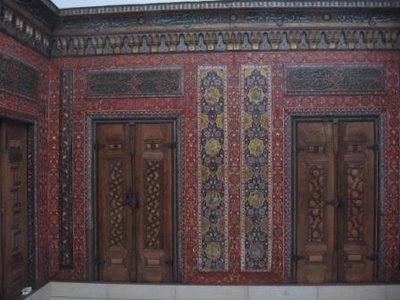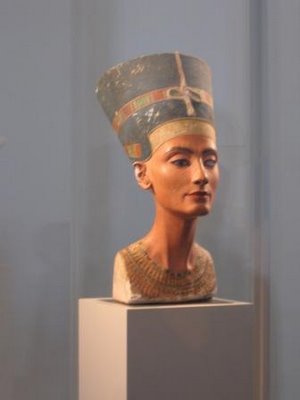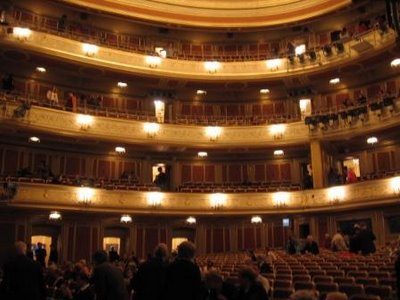Three Museums, a Cathedral and an Opera
 On Thursday, Mom and I had a marathon on Museum Island. That's right, those organized Germans have put all of their museums together on an island. I don't know how the plan originated, but I would think that it stems from a desire to keep all of their tourists contained somewhere out of the way. Tourists are, by definition, lost. If you put them all on an island, they are bound to find each other, even if they can't find anything else.
On Thursday, Mom and I had a marathon on Museum Island. That's right, those organized Germans have put all of their museums together on an island. I don't know how the plan originated, but I would think that it stems from a desire to keep all of their tourists contained somewhere out of the way. Tourists are, by definition, lost. If you put them all on an island, they are bound to find each other, even if they can't find anything else.We started in the Pergamon Museum and these are the Ishtar gates from Babylon. They are glazed baked bricks and were painstakingly reconstructed and recreated here. It's a breathtaking room, but both of us were curious about the daisy motif. We don't think of daisies as the flower of the Babylonian Empire. Is that just us? Do daisies grow in Babylon?
 Upstairs was an exhibit of Islamic art, which took us back to the Alhambra in Granada, Spain. We agreed that it was one of our favorite places. All of it was beautiful and intricate and decorative. Here and at the Alhambra both!
Upstairs was an exhibit of Islamic art, which took us back to the Alhambra in Granada, Spain. We agreed that it was one of our favorite places. All of it was beautiful and intricate and decorative. Here and at the Alhambra both! From the Pergamon Museum, we traipsed over to the Altes Museum, which also happens to have the Egyptian Museum in it right now until its new home in the Neues Museum is ready. We had to come here just to see Nefertiti's neck. It is nothing short of miraculous, that neck. Also a good thing that the Germans got her and not the Californians -- one teeny earthquake and she'd be in two pieces with that headdress. Nefertiti is aging well.
From the Pergamon Museum, we traipsed over to the Altes Museum, which also happens to have the Egyptian Museum in it right now until its new home in the Neues Museum is ready. We had to come here just to see Nefertiti's neck. It is nothing short of miraculous, that neck. Also a good thing that the Germans got her and not the Californians -- one teeny earthquake and she'd be in two pieces with that headdress. Nefertiti is aging well. Then, through a conversation in which I took part, but did not understand, we bypassed 60 some-odd frozen people waiting in line and went to the newly-reopened Bode Museum. We decided not to get stuck on the art, but just get a feel for the architecture. Mom decided that she is a big Eberhard von Ihne fan (don't tell Rob -- she thinks Schinkel is 'too square'; I'm reserving judgment until I find out whether von Ihne is as goodlooking as Schinkel; I cannot be a fan of someone with those unbecoming lambchop sideburns). They did have good art there -- we liked some marble sculptures, della Robbias, and a huge St. Sebastian that looked very Don Quijote-esque.
Then, through a conversation in which I took part, but did not understand, we bypassed 60 some-odd frozen people waiting in line and went to the newly-reopened Bode Museum. We decided not to get stuck on the art, but just get a feel for the architecture. Mom decided that she is a big Eberhard von Ihne fan (don't tell Rob -- she thinks Schinkel is 'too square'; I'm reserving judgment until I find out whether von Ihne is as goodlooking as Schinkel; I cannot be a fan of someone with those unbecoming lambchop sideburns). They did have good art there -- we liked some marble sculptures, della Robbias, and a huge St. Sebastian that looked very Don Quijote-esque. In the last twenty minutes before my class, we ran over to the Berlin cathedral. I showed her the side chapel where we got locked in while I was nursing Maddie (they tell you to 'pick a nice quiet spot' to feed your child -- got me into more trouble . . .). We also went down through the crypt and I think that the Hohenzollern family is in much better shape than the poor Habsburgs in Vienna -- their graves are depressing and dusty, not to mention that they're all in pieces with their hearts in this church, their entrails in another, and whatever's left in a third. Ugh! I ran off to class then, and Mom saw the Hackescher Hof and made her way home.
In the last twenty minutes before my class, we ran over to the Berlin cathedral. I showed her the side chapel where we got locked in while I was nursing Maddie (they tell you to 'pick a nice quiet spot' to feed your child -- got me into more trouble . . .). We also went down through the crypt and I think that the Hohenzollern family is in much better shape than the poor Habsburgs in Vienna -- their graves are depressing and dusty, not to mention that they're all in pieces with their hearts in this church, their entrails in another, and whatever's left in a third. Ugh! I ran off to class then, and Mom saw the Hackescher Hof and made her way home. That evening, I met back up with Rob and my parents at the Staatsoper to see the Magic Flute. We had wanted to see this production when we found out that they were basing it on the original sets designed by . . . Schinkel. Yup. He does doorknobs and castles, curlicues and pavilions, schauspielhauser and set designs. The Schinkel set design for the Queen of the Night happens to be the thing that we have hanging over our couch.
That evening, I met back up with Rob and my parents at the Staatsoper to see the Magic Flute. We had wanted to see this production when we found out that they were basing it on the original sets designed by . . . Schinkel. Yup. He does doorknobs and castles, curlicues and pavilions, schauspielhauser and set designs. The Schinkel set design for the Queen of the Night happens to be the thing that we have hanging over our couch.
It was a very traditional production, and the sets really did add a lot after seeing a spare version last year in Vienna. Pamina was astounding, Zarastro was phenomenal, and the Queen of the Night was wicked high. The animals were even notable, and they had over a dozen little Papagenos and Papagenas who ran out and jumped around at the end. I thought it was great.
I'll have to take Professor Keele's class on the Magic Flute to really understand it. He claims that it's all about the French Revolution; it also has lots of Masonic themes to explore in a seminar. But it seems to me that the Magic Flute is about marriage and in-laws. The strangeness to me is that Zarastro sun-king and Queen of the night, though they are opposites and enemies, are both for the marriage of Tamino and Pamina. I think that when people are engaged, each family of origin subconsiously hopes that the fiance will become part of their family, and the other family will just disappear into a trapdoor like the Queen of the Night. It's a sensible hope -- if some objective third party likes your family, then you've done something right, right? I'll keep working on it. Monostatos doesn't make any sense in my version.



Comments